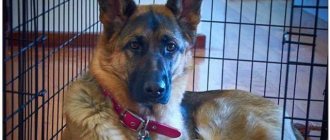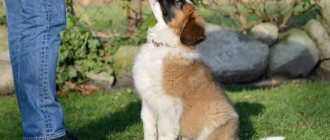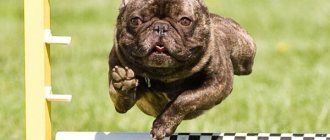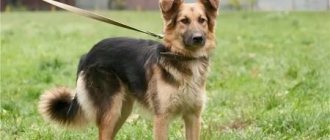Dog training is very important. Moreover, this applies equally to giant Caucasians or fighting pit bulls, as well as to miniature toy terriers and pugs. And one of the most important commands that your pet should learn first is “Fu!” It is simply impossible to overestimate its importance - it makes it possible not only to easily control the dog, but also to save lives in some cases. Therefore, even a novice breeder should know how to teach a dog the “Fu” command.
Forbidden fruit is always sweet
What does the "Fu" command mean?
Essentially, this command means a ban. Moreover, complete and categorical. As soon as the dog does something unacceptable, a prohibiting command must immediately follow.
This could be an attempt to rush at a person, start a fight with other dogs, pick up some kind of treat near the trash heap, an attack on the sofa or personal belongings of the owner. In all these cases, the animal must be stopped by firmly saying “Ugh!”
According to many dog handlers, the command is one of the most important, as it makes it easy to control the dog, regardless of its character and size.
The difference between the commands “Fu!” and “You can’t!”
Many dog owners, even relatively experienced ones, believe that there is no difference between the two commands. Therefore, they begin to accustom them to approximately the same way, or simply by choosing one of them as the main one.
Interesting ! An outdated analogue of the command “No!” is the command “Tubo!” came to pre-revolutionary Russia from France.
In fact, the teams, although close in meaning, are still quite different.
- For example, "Ugh!" is completely categorical. And they give it in appropriate situations - if the dog tries to eat something picked up on the street or run after a cat.
- Command "No!" has a slightly different meaning. It is given when some action cannot be performed temporarily. But in the very next second, the next order may follow, excluding the previous one.
As an example, we can give a situation - late at night, in the dark, a stranger approaches a man with a dog. The dog demonstrates aggression, after which he immediately hears the cry “No!” After this, a well-trained pet understands that it is impossible to attack a potential enemy. But if he shows aggression, the owner can instantly give the next command - “Face!” If in such a situation the command “Fu!” was used, then the dog immediately understands that aggression towards this person cannot be shown in principle.
Yes, it is not easy to achieve such an understanding. But a trained pet easily understands the difference between these two orders.
How to properly train a German Shepherd
Before training your shepherd begins, the pet should be neither too full nor too hungry. It is necessary to adequately use the puppy’s interest in treats when consolidating skills. They begin by practicing obedience in a familiar environment (at home), and later move on to practicing commands in unusual situations and unfamiliar surroundings (street, people).
Praise, treats, and toys as rewards are used no later than 2-3 seconds after the pet executes the command, otherwise the baby may interpret them ambiguously. Favorite treats are given in small portions.
Rewarding with a toy is one of the training methods
The German Shepherd distinguishes the timbres of the human voice. Since it is necessary to train a shepherd dog using short commands, they work only with three main timbres - affection (praise when the dog does everything correctly), order (command in a stern voice), threat (in case of disobedience). When commands are fully assimilated, it is necessary to gradually stop rewarding with treats, using only praise.
Important! The owner should always use one short set of commands, without changing either gestures or voice, or using synonyms and antonyms, so that the dog interprets them unambiguously. For example, it is unacceptable to move from orders to persuasion.
As an intermediate element of training, coercion is used - a mechanical action on the pet with the simultaneous issuance of a command - pressure on the sacrum, tension on the collar. But this method is only a method of training, not punishment, and as a result, compliance with the command should be encouraged.
The main functions of education and training are performed by the owner, who is the leader and leader for the dog. His authority is indisputable; the dog’s compliance with his requirements should not be questioned. Other family members must participate in training the shepherd, educate, and give commands so that the pet learns that it must obey everyone in its family.
It is necessary to devote a sufficient, but not excessive amount of time to training every day. For puppies up to 6 months of age, training should last 5-10 minutes, for older pets - no more than 20 minutes per session. Training should be positive, with maximum effort on both sides.
Socialization
Socialization – meeting family members, friends, forming a positive attitude towards the environment. The dog should not be isolated, it should be well behaved, it should not be allowed to jump and become overly excited. From 4-5 months of age, it is easy to teach a puppy to eat on command. To do this, give the command “No!”, lightly click on the nose, or remove the bowl of food. The baby must wait for the command “Eat!” The command "Fu!" in this case, it cannot be submitted, since it means a ban on all subsequent actions.
The puppy does not bite with the goal of hurting, it is a method for him to learn about the world around him, to play, to protect himself in the game. It is necessary to educate him in such a way that he understands that such an attitude is unacceptable. To do this, they abruptly stop the game, scream, and turn away. The German Shepherd is a contact dog; it perceives lack of attention as punishment.
Accustoming people to relieve themselves on the street begins after quarantine. To do this, you can use a diaper soaked in your pet’s urine outside; the familiar smell will encourage your pet to take the necessary actions. We can also use a method where the owner does not start playing until the puppy relieves himself. The child should be praised for successfully completed tasks.
Reference! You can’t blame your puppy for the puddles he makes at first. A dog starting to get used to using the toilet outside can take up to several weeks to learn this. When the baby learns the skill, he will begin to ask to go outside.
The following mistakes in socialization are unacceptable:
- Insufficient communication, because the owner is the main authority for the pet. Constant contact and mutual understanding, detailed and step-by-step training are the key to success.
- Irregular training with your baby will hinder more stable learning of skills. You need to train your pet dog every day, several times a day.
- Violating your own prohibitions. It is unacceptable to turn a blind eye to pranks if they break the rules, regardless of the circumstances.
Basic rules of training
Training must be severe.
There are certain rules for teaching a dog to the command “No” or “Fu!”
It is necessary to immediately decide which order will be submitted. You cannot train your dog to obey the order “Fu!”, and in a critical situation shout “You can’t!”, “Spit!” or "Don't touch." In this case, efficiency will drop to zero - the pet simply will not understand what exactly it should do.
Any disobedience should be severely punished - not only with a shout, but also with a spank or a blow. Cruel? Yes. But perhaps the habit of following a command will save your pet’s life in the future.
Parenting by age
The German Shepherd has well-developed skills. But you shouldn’t think that without proper training and upbringing, a pet can independently turn into a dog that follows commands and understands its owner perfectly. Initially, training should be carried out in the form of a game.
At the age of 1-2 months, the baby is quite capable of learning simple commands. The puppy needs to be taught to respond to his name. It is important to call with an inviting intonation.
The puppy is taught to wear a collar and muzzle, initially putting them on for 10-15 minutes, gradually increasing the time.
German Shepherds are prone to picking up trash and falling in the street. You need to immediately stop this with the command “Ugh!” Sometimes this behavior is associated with a lack of vitamins and microelements. In this case, you need to reconsider your pet's diet.
Walking outside begins at about 3 months. It is at this age that they begin to teach the baby to walk up the stairs. As soon as he learns to do this with the owner, you need to invite the dog to do it himself, without support. At the same time, it is advisable to introduce the animal to a barrier that it must learn to overcome. They start with the smallest heights, which are constantly increased. It is important to reward your puppy by giving him treats.
At 4 months, the German Shepherd needs to be trained intensively, making the exercises more difficult all the time. In addition, sequential alternation of commands is introduced. If in the future you have to do guard, service or security work, then you need to teach your baby to bark at strangers. Strangers should not be allowed to treat the dog or play with it.
By 6 months, a German Shepherd puppy is already large in size and its character begins to change. The owner does not need to succumb to the dog’s provocations, as it will become disobedient. By 8 months, guarding qualities appear, and male dogs may show leadership abilities. Adult trained German Shepherds are very obedient and capable of becoming protectors and helpers of their owners.
Why teach your dog the “Fu” command?
Some breeders are perplexed - why teach the dog this order if he is on a leash every minute of the walk - he is already easy to control.
On a note ! Some dog trainers recommend using a harness rather than a collar during training.
But it is not always the case. For example, a Caucasian Shepherd dog or a diver is not easy to control even for a strong, strong man. What can we say about a fragile woman or a thin teenager - a powerful dog can easily drag them along. But if you train him to follow orders in time, then shouting will be enough to prevent trouble.
Useful tips
Sometimes you have to use an electric collar
Many experts recommend using "Foo" only in the most extreme cases - to prevent fighting with other dogs, attacking people, or eating garbage. The command is categorical and should be used as rarely as possible.
For training, you can artificially simulate the situation - for example, go to a place where other dogs go or there are definitely things that your pet wants to eat.
Drag
Always follow the basic rule: any game immediately stops if your dog's teeth touch your skin. This will help avoid injuries and bites in the future, and teach the dog to be more attentive.
It will take time to teach your dog commands. Use positive reinforcement and treats.
Contrary to popular belief, it's okay to let your dog beat you sometimes.
. This is a good tactic to help your dog develop confidence, and it does not automatically make the dog think of himself as the leader.
Features and main mistakes when training a dog
The most common mistake is not issuing a command in a timely manner. You cannot shout “Ugh” at the moment when the owner sees a cat that the dog has not yet noticed. This behavior of the leader will simply confuse his four-legged friend - he will not understand what exactly should not be done.
Also, you cannot hesitate - if something forbidden has already been picked up and eaten with appetite, then the order is unlikely to force the dog to stop the action. It should sound at the moment when the dog has already rushed to the “treat”, but has not yet begun to eat it.
Yes, it's not easy. But only in this case will the training be truly effective.
Find some treats!
To begin, place treats on the floor while your dog is in the "Wait" position. Give your dog the release command and call “Find Treats.” Point to them and say “Yes.” Reward by praising each time your pet finds a treat.
Next, you can slowly begin to increase the difficulty of the places where you hide treats. Go from one room to the whole house.
If you use a clicker, you can mark the exact moment your dog made the right choice.
Thimblerig.
This is a game in which you hide a treat under one of two or three identical cups and then move them around, allowing the player to choose the correct cup.
I recommend: Arthrosis in dogs
Guess which hand.
This is where the "Touch" command comes in handy.
Advice:
Sliced carrots are great for scent play and training. It's low in calories, easy to prepare, and most dogs love it.
The basic algorithm for teaching a dog the “Fu” command
It is very difficult to control a dog without training.
Now it’s time to figure out how to teach a puppy the “Fu!” command.
It is advisable to practice it not at home, but on the street, so to speak, in conditions close to combat. For example, when passing by garbage cans, a dog will probably see something tasty and try to pick it up. Or, seeing a cat, he will rush to it. The command “Fu!” should immediately follow, which is accompanied by a sharp jerk of the leash.
Important ! When pulling the leash, you need to be strong so as not to harm the pet by squeezing the throat.
The dog must quickly understand that the owner is in complete control of the situation and it is impossible to resist him. As a rule, after several training sessions he understands what is required of him - after that, tugging on the leash becomes unnecessary, one shout is enough.
Puppy care
It is important not only to know how to raise a German Shepherd, but also how to properly care for this animal. From the first months of birth, the dog should become a reliable companion. Responsibility for its condition and health depends entirely on the owner, since no matter how smart the dog is, it will not be able to take care of itself. It is imperative to follow the following care rules:
- proper feeding;
- vaccination;
- well-being tracking;
- regular ear cleaning;
- coat care;
- uniform load distribution.
In addition to the basic aspects of care, it is important to teach your pet to respond to a nickname. This skill should be developed in the process of raising a pet. In the first months, vaccination is required, which is why the owner must get all the required vaccinations to avoid any problems with the puppy’s health.
It is important to stick to your diet. You need to give your dog food at the same time, in the same place. Babies are fed three times a day. An adult German Shepherd should eat twice a day.
The place where the dog sleeps must be kept clean. Periodically you need to bathe the animal in special shampoos or with laundry soap, and also comb out the hair. When the dog is well-groomed, it will not create any discomfort in the house.
With the right approach, you can raise an intelligent friend and a real guard, but this requires a little effort.
Tips from dog handlers
In the end, it’s worth giving a few tips from dog handlers that will simplify training and make it more effective:
- When training disobedient dogs, additional stimuli should be used - from electric collars to dog whistles.
- It is advisable to combine the execution of the order with the command “Come to me!” to reduce the risk of repeated violation.
- The command must be carried out when given by any family member - otherwise it will be very difficult to control the dog.
By fulfilling all these conditions and properly training a pet that has recently appeared in the house, the breeder will certainly be able to save himself and the pet from many problems in the future. Therefore, you should not neglect this precise command.











